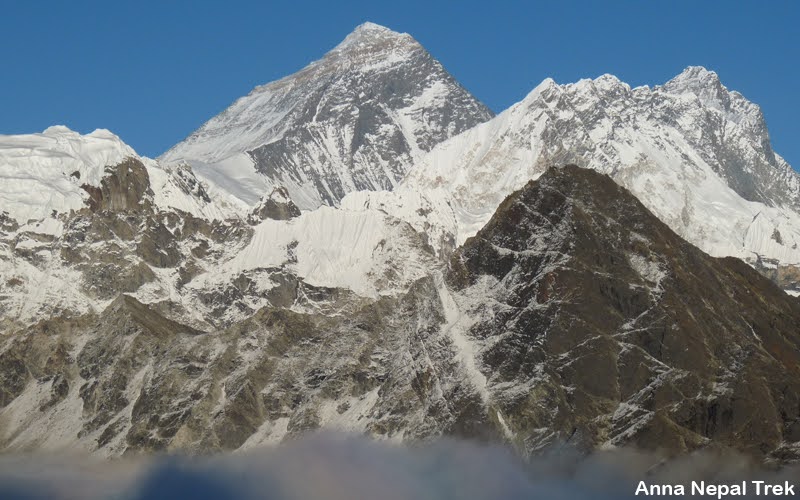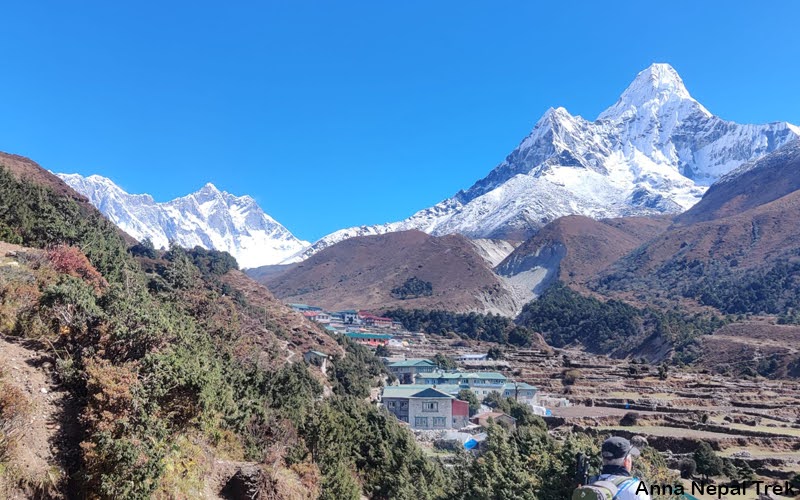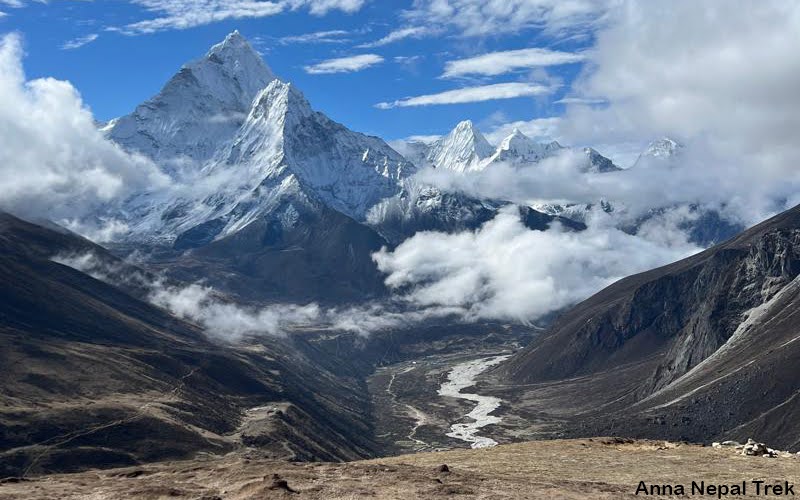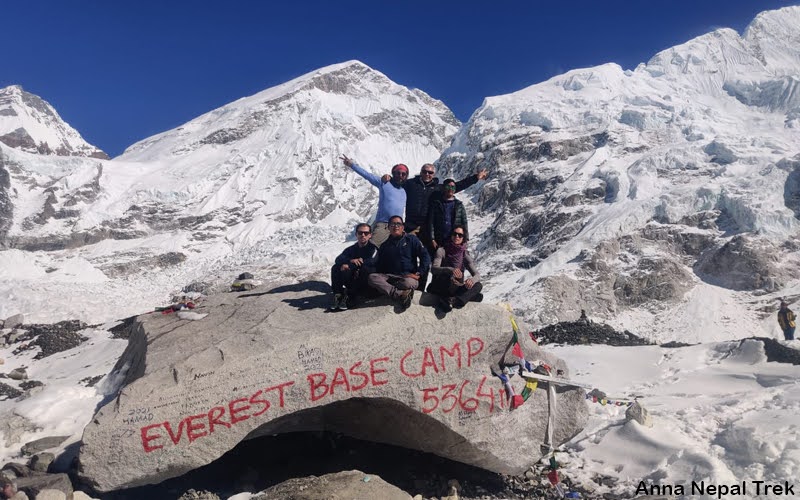The trek to Everest Camp isn’t just about the destination but also about experiencing one of the most beautiful Himalayan valleys and the unique culture it nourished. The Everest region is filled with spectacular glaciers, tall peaks, and deep valleys containing centuries-old Sherpa settlements. This isolated Himalayan haven is protecting a unique ecological and cultural legacy, turning the trip into much more than an expedition of the body.
Be prepared to wander through areas that bring the legend of the Yeti to life, the elusive snow leopard wanders fearlessly, and the shy Red Panda stares curiously as you amble. Stay with a Sherpa family and explore the villages where life’s rhythms are undisturbed and happiness is in the air. But all of these come with a price of a formidable hike. If planned well, a reward is extraordinary.
Here are some tips and advice to help you make your Everest Base Camp trek an experience you’ll never forget.

Mt Everest (center) and Lhotse (right) seen from flight to Lukla
Start with a Scenic Flight to Lukla
It’s in the sky where the adventure begins, with a heart-stopping flight from Kathmandu to Lukla. Famous as one of the world’s most dramatic short-haul flights, it wings along the snow-dusted ridges of Langtang, Rolwaling, and Numbur Himal. Ask for a window seat on the left side of the plane (left side as you face the pilot) for the best views of the mountains on the 35-minute flight.
Catch a Rare Glimpse of Kusum Kanguru Peak
The beauty of the Everest trek begins to unfold right from the first day. When you trek from Lukla to Phakding, take a memorable pit stop in Ghat. It is your only opportunity to see Kusum Kanguru Peak marvelously framed by a lush V-shaped gorge. Have a meal here and appreciate being in a different world.
Don’t Miss Khumjung and the Mysterious Yeti Scalp
Having a rest day in Namche Bazaar is a must for acclimatization. Don’t forget to hike to Shyangboche Ridge and explore Khumjung village. You won’t just get panoramas over the whole of the Khumbu range (Mount Everest and all), but you’ll arrive in the traditional Sherpa village huddled under sacred Mount Khumbila. Khumjung is home to one of Sir Edmund Hillary’s schools and a local monastery which holds a supposedly Yeti scalp!

Lhotse and Mt Ama Dablam seen from Pangboche village
Watch the Sunset Over Everest from Tengboche
A sunset view of Tengboche is the best in the entire trek. The ridge is the closest point looking at the panorama with most of the snow peaks, including Mt Everest. Hang around until sunset and watch as the peaks turn a brilliant golden — it’s magic. Beyond this point, Everest comes into view once more only from Gorakshep.
Essential Tips for a Safe and Enjoyable Trek
Permits You’ll Need
To enter the Everest region, you’ll need:
- Sagarmatha National Park Permit
- Khumbu Pasang Lhamu Rural Municipality Entry Permit
- TIMS is not required in the meantime. But check if they reintroduce TIMS
Both of the above permits could be issued on the trail as you go.
Should You Hire a Guide or Porter?
Hiring a local guide and porter is highly encouraged. A knowledgeable guide can enhance your journey with cultural stories and ensure your route is safe. A porter will ease your load, letting you focus on the beauty around you.
For personalized trekking services, check out this trusted Nepal trekking company, Anna Nepal Trek Pvt. Ltd., which offers guided treks, cultural tours, and customized Himalayan adventures.
Physical Preparation is Key
This trek is challenging. The altitude and terrain can even make the legs of a seasoned hiker weigh heavy. A decent fitness routine involving cardio, strength and endurance, weeks before the trip will be significant. If you have medical issues, consult with a doctor before attempting this.
Acclimatization is Not Optional
High altitude trekking and sojourn One of the key essentials to effective high-altitude trekking is proper acclimatization. Just follow the popular schedule, which lays in rest days in Namche Bazaar and Dingboche to help you acclimate. By ignoring acclimatization, you greatly increase the chance of getting altitude sickness, which if not taken care of, can be fatal.

Backward view of Ama Dablam form Labuche
What to Pack: Everest Base Camp Checklist
- Warm layers, including a down jacket and thermal innerwear
- Broken-in trekking boots with ankle support
- Sunglasses with UV protection and sunscreen
- Gloves, hat, and moisture-wicking socks
- Reusable water bottle and water purification system
- First aid kit, including medications for altitude sickness
- Headlamp and spare batteries
- Lightweight sleeping bag rated for sub-zero temps
- Trekking poles and energy snacks
- Lightweight backpack (ideally 45–65 liters)
Food, Hydration & Staying Healthy
Teahouses along the trail serve a mix of Nepali, Tibetan, and Western dishes. As you gain elevation, the options get simpler but more expensive. Carrying high-energy snacks like nuts and protein bars is a good idea.
Stay hydrated and always purify your drinking water. Bottled water is available but pricey, and plastic waste is discouraged in national parks.
Watch for Altitude Sickness
Be aware of early symptoms such as:
- Headaches
- Loss of appetite
- Fatigue and nausea
If these symptoms worsen, descend immediately and rest. Acclimatize slowly, hydrate well, and avoid alcohol.
Unpredictable Weather
Even during peak seasons (spring and autumn), the weather can turn quickly. Pack for cold, wind, and the possibility of snow. Rain jackets and waterproof covers for your gear are also must-haves.

Everest Base Camp (5,364 m)
Don’t Forget Travel Insurance
Make sure your travel insurance covers:
- High-altitude trekking (up to 5,500 meters)
- Emergency evacuation
- Trip delays and cancellations
This is particularly important given the unreliable flight schedules to Lukla.
Cultural Awareness and Respect
You are walking through villages where the Sherpa people have lived for generations. Show respect by:
- Asking before taking photos of people or homes.
- Not touching sacred objects or shrines.
- Following local dress norms and removing shoes in monasteries.
- Always walk around Chortens (Stupas), Mani walls or other sacred object clockwise.
Lukla Flight Updates
Flights to Lukla are frequently delayed or rerouted to Ramechhap Airport, about 4–5 hours from Kathmandu, especially during peak trekking months. Allow some buffer days in your itinerary to accommodate these changes.
Best Time to Go
The ideal times to trek Everest Base Camp are
- Spring (April–May): Clear skies, blooming rhododendrons
- Autumn (September–November): Stable weather, crisp mountain views
Avoid the monsoon (June–August) and the deep winter (December–February) unless you’re an experienced trekker prepared for harsh conditions.
Final Thoughts
The trek to Everest Base Camp is more than just a physical challenge—it’s a journey into the heart of the Himalayas. With the right mindset, preparation, and a bit of flexibility, your adventure will be filled with unforgettable views, meaningful cultural encounters, and personal milestones.
If you’re looking to embark on this incredible journey with the help of a reliable local outfitter, explore customized trekking packages in Nepal designed for comfort, safety, and unforgettable memories.